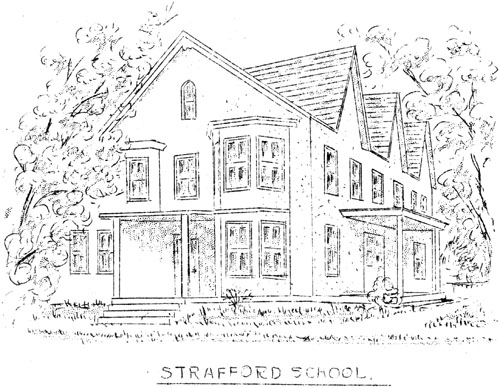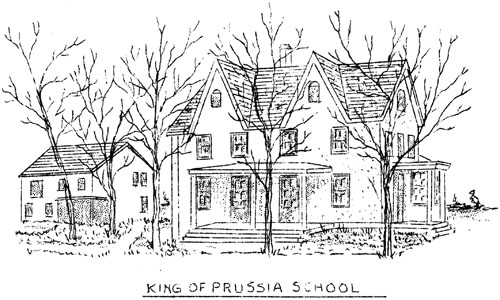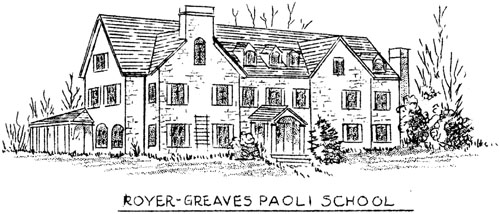|
Home : Quarterly Archives : Volume 9 |
||||||||||||||||||||||||||||||||||
Tredyffrin Easttown Historical Society |
||||||||||||||||||||||||||||||||||
|
Source: October 1957 Volume 9 Number 4, Pages 84–88 The history of Royer-Greaves School for Blind : Paoli, Pennsylvania Royer-Greaves School for Blind was opened January 1, 1921, in Strafford, Pennsylvania, by Mrs. Jessie Royer Greaves. At that time Mrs. Greaves was teacher of Declamation and Physical Expression at the Overbrook School for Blind in Philadelphia, which position she had held for nineteen years. She had taught every pupil in that large school and her work required a study of the possibilities of each one. It distressed her very much when a slow-learning child was dismissed as feeble minded, never to have another opportunity for training or education. At that time the feeble minded were regarded as a disgrace, and hidden away. For several years Mrs. Greaves sought some way in which the educable blind retarded child could be saved from oblivion. When she was left a childless widow, she decided to try to do this herself. She rented a large house and with her mother, Mrs. J. Warren Royer of Trappe, and Miss Catherine Lanning, a librarian from Philadelphia, as members of her family, she opened the first school for retarded blind children. The first pupil came from Virginia in February and the second came in March from New Jersey. One teacher and one house mother were employed for the care and instruction of these pupils. Mrs.Greaves and Miss Lanning also gave all possible time to teaching these children. A music teacher was added to the staff that year. In September, 1922, Mrs. Greaves purchased the West property at King of Prussia and moved the school there. Five regular pupils were admitted and the State of Connecticut was added to its patrons. The next few years were those of steady growth. The summer population of pupils was increased to twenty-five by the temporary stay of pupils from the Overbrook School for Blind during their vacation. Mr. Howard T. Wolf was added to the staff, supplying the much needed "Father element" to the family life, and Dr. Herbert Burk of Valley Forge became a warm friend of the school.
Strafford School Mr. William H. Flanigan, the builder, altered the inside of the house, changing a two-family house into a one-family home with modern heating and plumbing. He carried the bills until the school could pay them. In 1926 the Kiwanis International of Norristown named Jessie Royer Greaves "the person doing the most unselfish service in Montgomery County", awarding her the Kiwanis Distinguished Service Medal. This aroused local interest in the school which was later augmented when the Lions Club of Norristown made Royer-Greaves School its major project. In 1927 the home life of the school suffered a great loss in the death of Mr. Howard T. Wolf, who died as a result of injuries received in the First World War, having made Royer-Greaves School the beneficiary of his insurance. That year Mrs. Greaves resigned her position at the Overbrook School after twenty-five years of service, and devoted all her time to teaching at Royer-Greaves. The first issue of the Royer-Greaves Monthly was published in 1929.
King of Prussia School During the next decade the school continued a steady growth. Due to the influence of Dr. Edward E. Allen, Director of Perkins Institute for the Blind in Massachusetts, all the New England states sent pupils to Royer- Greaves School. The number of pupils was increased to twenty-three and the faculty to eight. A new workshop was added to the building; later, a new kitchen and a room for Domestic Science. Finally, an eight-room addition, containing five bedrooms, two school rooms, an office, a fire tower and laundry, was added. With increased space, more pupils were accepted, and in 1940 twenty-eight pupils made it necessary to seek larger quarters. Mrs. Greaves was able to sell the King of Prussia property and to acquire the Hoopes estate in Paoli. This was a valuable property with two houses and beautiful grounds. In January 1941 the school was moved to Paoli. The following year, thirty-two pupils were enrolled, with Texas, Ohio, and Michigan added to its patrons. In 1943 Pennsylvania placed Royer-Greaves School for Blind on its list of State-aided Schools and assumed the financial responsibility for Pennsylvania pupils. Up to that time these pupils were accepted, but it was necessary to solicit funds to meet the running expenses. The income, including the proceeds of Mrs. Greaves' recitals and her Overbrook salary, was insufficient to do this. It has always been necessary to depend upon donations for building purposes. In 1943 Royer-Greaves School for Blind was incorporated and the property was deeded to the Corporation. During the war which followed, it was impossible to get household help. The resident teachers, though visually handicapped, served as house parents and Mrs. Greaves as cook. An excellent gardener took care of the gardens and the cows, pigs, ducks, geese, turkeys and chickens, so the school had plenty of food. However, the cost of feed for the animals was almost prohibitive, so when the school received a legacy from John Peyton, it was decided to buy a farm. The call to help premature blind babies was insistant, (sic) so a farm was purchased containing a manor house which was altered to meet the needs of eighteen little ones. Peyton Hall was opened in 1947, and since then many of the little folk who received their training there have become pupils in the Paoli school. Illinois, New York, Delaware, Colorado, Montana and North Carolina have been added to the list of states from which pupils have been admitted to Royer-Greaves School. When the pupil population at Paoli reached forty-five, it was necessary to provide classrooms outside the home buildings. In 1955, a schoolhouse was erected which provides adequate space for six classes and includes an assembly room, workshop and domestic-science room. Now, in 1957, Peyton Hall is inadequate to meet the needs of its increasing population, so plans are being made for a new Peyton Hall to be built on the Paoli campus. It might be well to add that Mrs. Greaves has never accepted any remuneration from the School other than her room and board.
BIOGRAPHICAL NOTES
Royer-Greaves Paoli School |
||||||||||||||||||||||||||||||||||


